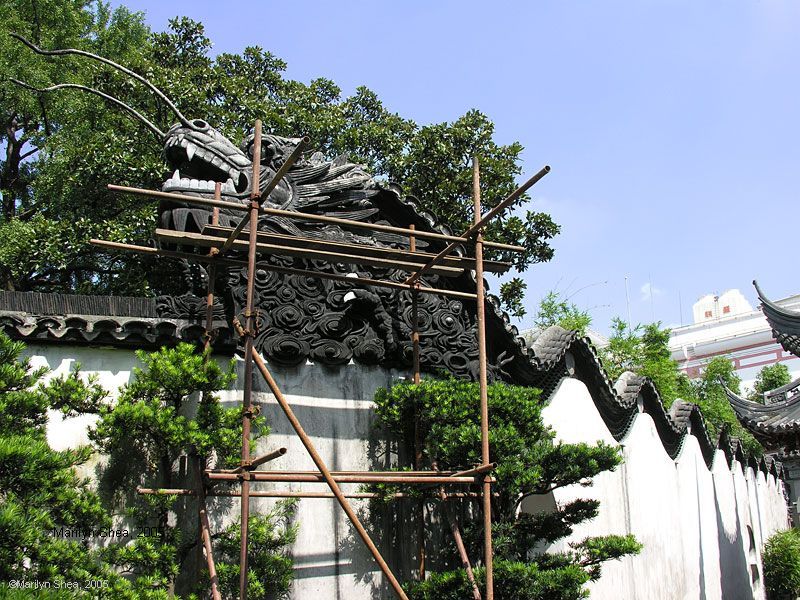 |
| The Nine Dragon Wall 九龙壁 (Jiǔ Lóng Bì) is a relatively recent addition to the Forbidden City. The wall was built in 1773 as a part of a large renovation of the northeastern section of the palace to create a retirement villa for Emperor Qianlong (1735-1796). The wall is located east of the Outer Court and the Hall of Preserving Harmony 保和殿 (Bǎo Hé Diàn). I don't want to confuse you, but a break from thrones and golden roofs seemed like a good idea. We will see other sections of his buildings and gardens later on.
The Nine Dragon Screen, or Wall, was built to provide privacy by blocking the view through the Gate of Imperial Supremacy (Huangji men) into the Palace of Tranquil Longevity (Ningshou gong). The screen is 96.5 feet long and 11.5 feet tall. Such walls also denied access to evil spirits, which must travel in straight lines. If you place a wall in front of a gate or main entrance to a home you answer both needs. In traditional homes, the entrance is often through a short alley ending in a wall faced with a decorative design. The actual entry is in the side wall, usually the left wall, at the end of the dead-end alley. The angled entry serves the same functions. The Nine Dragon Screen was inspired by one that can be seen in Beihai Park, to the north of the Forbidden City. The dragon is the symbol of power, but is also symbolic of luck, prayers for rain, a god to control floods, and in some cases, is symbolic of longevity. Notice that the dragons are swimming in the ocean waves. The Chinese dragon does not breathe fire and kidnap maidens. The Chinese dragon is a benevolent creature that saved mankind from drought by making it rain. The dragon also has the power to calm waters, so when a river floods, a dragon is called upon to dispel the waters. There are many different characters and personalities for various dragons within Chinese mythology. For instance: → Haoxian is a reckless and adventurous dragon whose image can be found decorating the eaves of palaces. → Yazi 睚眦/睚眥 can be found engraved on the handles of knives and the hilts of swords. Yazi is brave and belligerent. → Chiwen 螭吻/鴟吻 is seen on top of things. If you look at the roof-ridge of a building, his image is often carved there so he can gaze into the distance and provide early warning. → Baxia 霸下 is most often found near water. His image will be carved on bridges and arches leading to piers so that he can take a swim when he likes and protect the traveler from the water. → Pulao 蒲牢 Pulao is fond of his own voice and likes to roar, so his image is carved on bells. → Bixi 贔屭 is actually has a tortoise shape, but is considered to be one of the dragon legends. The Bixi is an excellent pack-animal whose image appears on panniers. Bixi are represented on the sides of grave-monuments and are frequently carved as the base for important memorials. → Qiuniu 囚牛 loves music and he likes to hang around the bridge of stringed musical instruments. → Suanmi 狻猊 is fond of smoke and fire, so he twines up the legs of incense-burners. Suanni, which like to sit down, are represented upon the bases of Buddhist idols (under the Buddhas' or Bodhisattvas' feet). → Jiaotu 椒圖 can keep his mouth shut like a clam. He appears as either a conch spiral shape or a clamshell shape. He is found on door lintels, front doors, and major entryways. He guards your peace and privacy. → Bi'an 狴犴 guards the gates of prisons. Bi'an is the law and order type so are the symbol of litigation. There are many more Chinese dragons. Each has its own story and place in a complicated and ever changing hierarchy. Details give clues to their identities. For instance, an imperial dragon has five toes on each foot. Most of the minor dragons have three toes. Only the emperor was allowed to display images of imperial dragons. It was part of the rites of ancient traditions: the rites that Confucius believed cemented a culture together by clearly delineating the position of the ruler as separate and above those of lesser rank. It was an insignia of office, like the stars on a five star general, but had much deeper import. The rites helped to maintain the balance of order between the heavens and the earth. When followed, the rites brought good fortune, health, and prosperity to both an individual and to the nation. Should a commoner display a five-toed dragon, it would mean the weakening of the nation and it would bring bad luck to the commoner. One of the signs that Confucius pointed to as a signal of the downfall of a dynasty was the performance of rites above one's station. When kings played at being emperors, when dukes played at being kings, and when magistrates played at being dukes, the end of civilized rule was near. In the 1600s, an important official in Shanghai, named Pan Yunduan, built a garden mansion called Yu Yuan 豫园 for his family. The walls were topped by dragons whose tails spread all along the tops of the walls. As the story goes, the dragons originally had five claws, and someone tattled to the emperor. Fortunately, word reached Shanghai in time. When a representative of the emperor reached Shanghai to investigate, the dragons had been declawed. The choice was between cutting off a claw or cutting off a head. Pan Yunduan chose to cut off the claw. The image below is from Yu Yuan in Shanghai. Further images can be found HERE. |
 |
http://hua.umf.maine.edu/China/HistoricBeijing/Forbidden_City/index.html
Last
update: January 2010
© Marilyn Shea, 2009